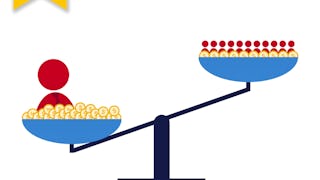This course is aimed at anyone who has interest in the lens through which mathematicians view democracy. You will learn theories and approaches to the mathematics of voting.



Expérience recommandée
Expérience recommandée
Ce que vous apprendrez
Mathematics of voting
Theories of democracy
Détails à connaître
4 devoirs
Découvrez comment les employés des entreprises prestigieuses maîtrisent des compétences recherchées

Il y a 4 modules dans ce cours
This module sets the stage for the entire Teach Out. We begin by discussing the nature of mathematics (as opposed to arithmetic) and develop a workable abstract model for democracy: a function that takes individual preferences and returns a group decision. We then look closely at different methods for two-party elections, fairness criteria we want these functions to have, and conclude that only the Simple Majority method satisfies those criteria.
Inclus
6 vidéos1 lecture1 devoir2 sujets de discussion
This module builds on the work from Module 1 by considering elections with three (or more) candidates. We examine various decision functions (such as Plurality and Borda Counts) as well as properties we want those functions to have. We conclude with Arrow’s Theorem that shows that there are no decision functions satisfying basic fairness criteria.
Inclus
7 vidéos1 lecture1 devoir2 sujets de discussion
In the previous modules we assumed that each voter ranks the candidates from most to least desirable; these individual rankings are the inputs to the decision functions. In this module we question the viability of asking voters to rank both for psychological reasons (it is very difficult to rank a long list of options) and—more to the point of this Teach Out—for mathematical reasons. We model preference using a simple game played with dice that illustrates non-transitive preference: A is better than B, B is better than C, but C is better than A!
Inclus
3 vidéos1 lecture1 devoir1 sujet de discussion
This module considers mathematical issues arising in representative democracy in which elected officials make decisions for the larger population. In the United States House of Representatives, the number of representatives from a given state is proportional to the population of that state. However, since the number of representatives from a state must be a whole number, and the total number of representatives is 435, we need a method by which seats are allocated to states. We present the apportionment methods of Hamilton and Jefferson, and discuss problems arising with these methods. We conclude with a theorem of Balinsky and Young that shows there are no apportionment methods satisfying basic fairness conditions.
Inclus
7 vidéos3 lectures1 devoir1 sujet de discussion
Instructeur

Offert par
Recommandé si vous êtes intéressé(e) par Math and Logic


Johns Hopkins University


Utrecht University


Johns Hopkins University


Duke University
Pour quelles raisons les étudiants sur Coursera nous choisissent-ils pour leur carrière ?






Ouvrez de nouvelles portes avec Coursera Plus
Accès illimité à 10,000+ cours de niveau international, projets pratiques et programmes de certification prêts à l'emploi - tous inclus dans votre abonnement.

Faites progresser votre carrière avec un diplôme en ligne
Obtenez un diplôme auprès d’universités de renommée mondiale - 100 % en ligne

Rejoignez plus de 3 400 entreprises mondiales qui ont choisi Coursera pour les affaires
Améliorez les compétences de vos employés pour exceller dans l’économie numérique
Foire Aux Questions
Access to lectures and assignments depends on your type of enrollment. If you take a course in audit mode, you will be able to see most course materials for free. To access graded assignments and to earn a Certificate, you will need to purchase the Certificate experience, during or after your audit. If you don't see the audit option:
The course may not offer an audit option. You can try a Free Trial instead, or apply for Financial Aid.
The course may offer 'Full Course, No Certificate' instead. This option lets you see all course materials, submit required assessments, and get a final grade. This also means that you will not be able to purchase a Certificate experience.

